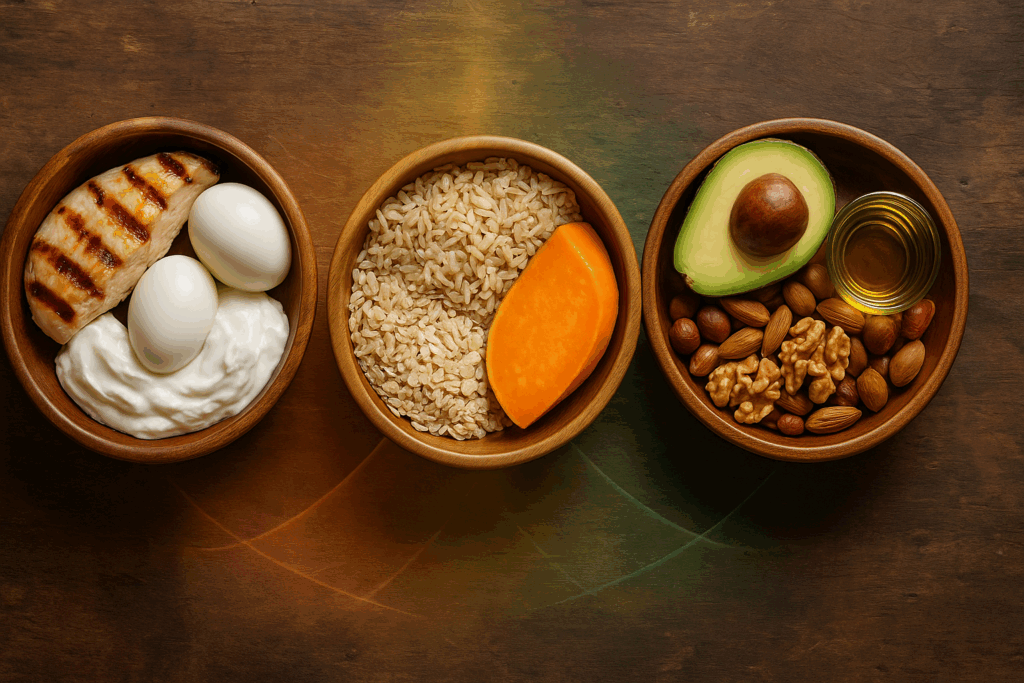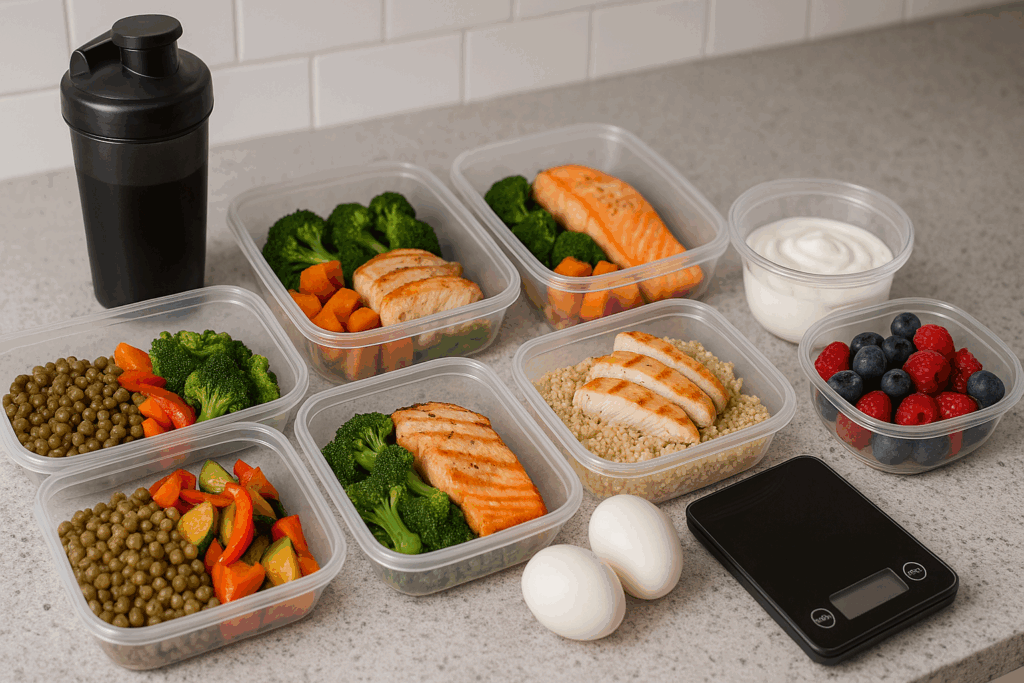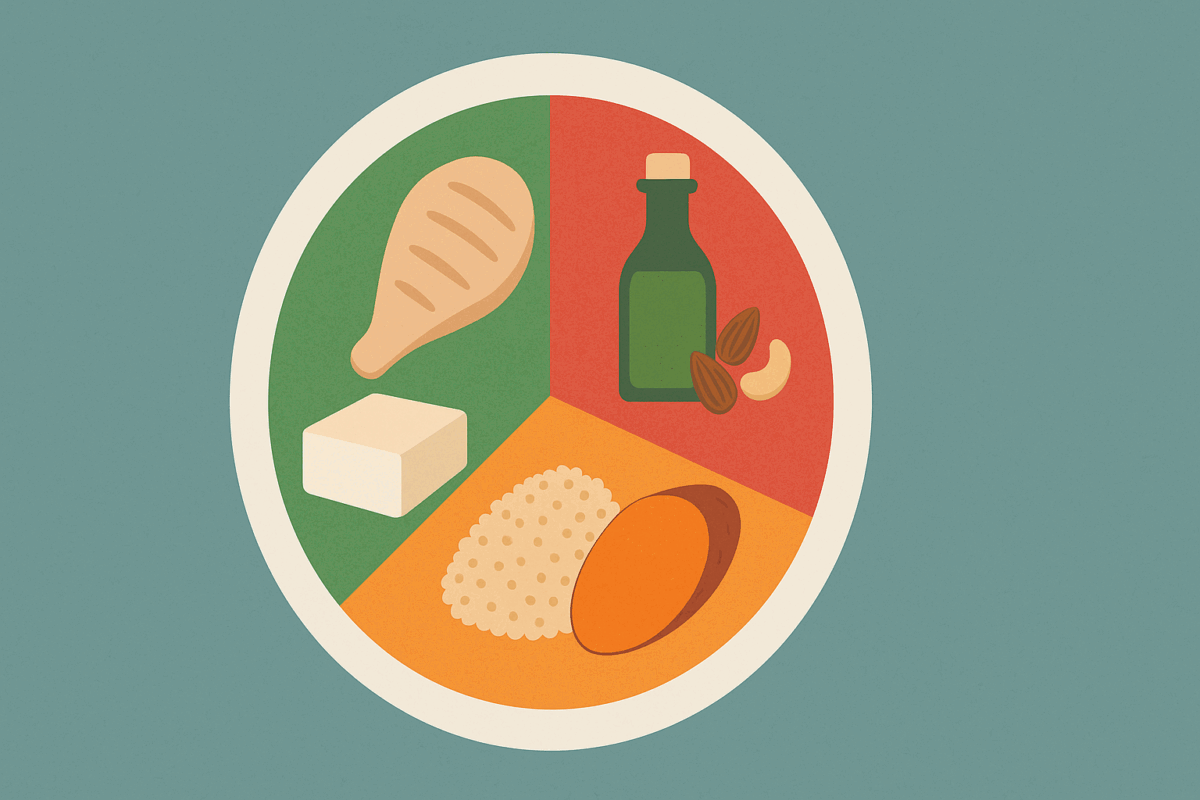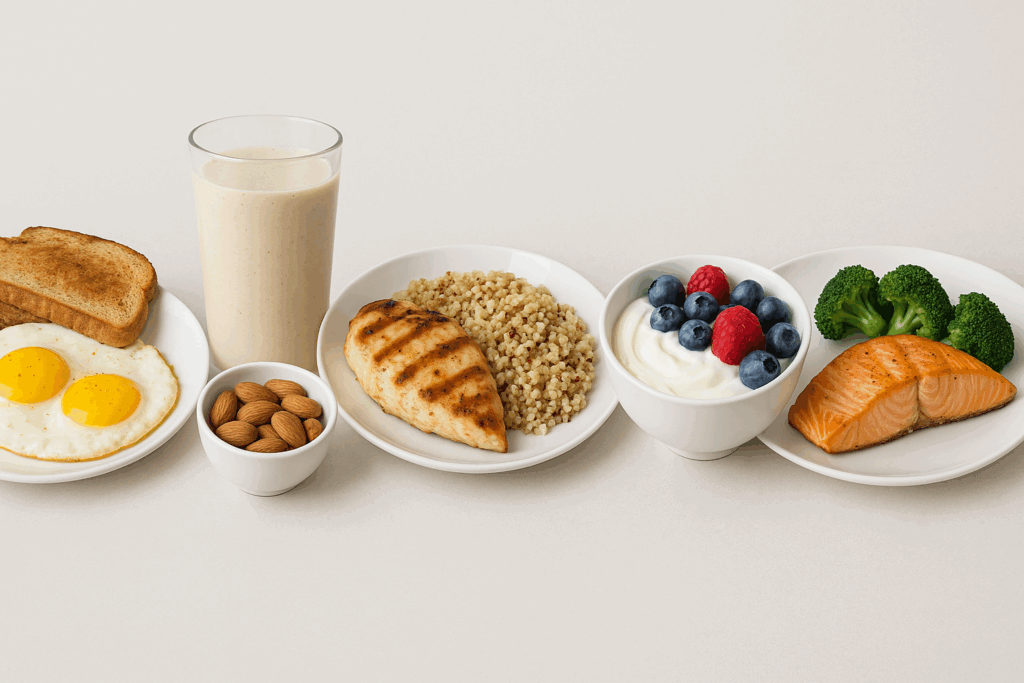Introduction: Why a High-Protein 2000 Calorie Meal Plan Matters for Strength and Muscle
Fueling the body effectively is a cornerstone of performance nutrition, especially when the goal is to build strength and muscle. The structure of a 2000 calorie meal plan high protein diet offers a reliable framework for supporting these goals while keeping energy intake in a manageable range. For many athletes, fitness enthusiasts, and individuals engaged in resistance training, this approach provides an ideal balance of macronutrients—ensuring adequate protein for muscle repair and growth, carbohydrates for performance, and fats for hormonal function and cellular health.
The importance of tailoring caloric intake to match training intensity and body composition goals cannot be overstated. A 2000-calorie daily intake is suitable for a wide range of adults, particularly when adjusted slightly to accommodate variations in metabolism and training volume. When protein is emphasized within this framework, it becomes an incredibly powerful tool for optimizing body composition. Beyond muscle gain, this kind of plan supports satiety, improves recovery, and can aid in the maintenance of a lean physique.
This article explores the foundations and applications of a high-protein 2000 calorie meal plan designed specifically to promote strength and muscle development. We will examine nutritional principles, daily meal structure, food selection, and real-world applications backed by scientific understanding. Readers will also gain insights into common pitfalls and expert strategies to ensure their meal planning aligns with both performance and health goals.
You may also like: The Ultimate Guide to Powerful Weightlifting Nutrition for Strength and Muscle Gains
Understanding the Nutritional Foundations of a 2000 Calorie Meal Plan
Designing an effective 2000 calorie meal plan begins with understanding its core components. Calories are a measure of energy, and consuming 2000 calories per day provides a structured amount that can help maintain, gain, or even lose weight, depending on the individual’s activity level and metabolic rate. However, when the focus shifts toward muscle building and strength, the quality and composition of those calories become paramount.
A well-balanced high-protein diet prioritizes macronutrients in a way that enhances anabolic signaling in muscles. Protein needs are significantly elevated for individuals engaging in strength training. The recommended dietary intake of protein for the general population is about 0.8 grams per kilogram of body weight, but athletes and strength trainees may benefit from consuming between 1.6 to 2.2 grams per kilogram to support optimal muscle protein synthesis.
Carbohydrates, often overlooked in favor of protein, are essential for performance. They replenish muscle glycogen, provide energy for high-intensity efforts, and help modulate recovery. Healthy fats are equally vital, contributing to hormonal balance, particularly testosterone production, and offering sustained energy.
To effectively distribute 2000 calories in a high-protein format, the general macronutrient breakdown might target around 35–40% of total calories from protein, 30–35% from carbohydrates, and 25–30% from fats. This distribution allows for nutrient-dense meals that are satisfying, recovery-focused, and tailored for hypertrophy and strength gains.

Crafting the Ideal 2000 Calorie Meal Plan High Protein for Muscle Growth
When building a 2000 calorie meal plan high protein regimen, strategic planning of meals and snacks is essential. This involves not only selecting the right foods but also timing intake to maximize recovery and adaptation. Meal frequency and spacing should support steady energy levels and protein availability throughout the day.
Start with a foundation of whole, minimally processed foods. Lean meats such as chicken breast, turkey, and lean beef offer excellent protein quality. Plant-based sources like lentils, chickpeas, tofu, and tempeh are great for vegetarians and vegans. High-protein dairy items—Greek yogurt, cottage cheese, and whey protein—also contribute significantly.
Each meal should contain at least 25–35 grams of protein. For a 2000-calorie high-protein plan, this often equates to four or five eating occasions per day. Breakfast might include eggs with whole grain toast and avocado, while lunch could feature grilled chicken, quinoa, and steamed vegetables. A post-workout shake ensures rapid protein delivery, and dinner might revolve around baked salmon with roasted sweet potatoes and spinach.
Strategically including snacks can help hit protein targets and prevent muscle breakdown between meals. Examples include boiled eggs, protein bars (with minimal added sugars), roasted edamame, and protein smoothies blended with fruit, seeds, and Greek yogurt. Balancing these choices ensures not only muscle growth but also the nutritional diversity necessary for long-term health.

2000 Calorie Meal Plan High Protein: Structuring Your Daily Macros for Strength
A precise macro structure can significantly enhance the effectiveness of a 2000 calorie meal plan high protein framework. Let’s break it down into calories per macronutrient to understand this distribution:
- Protein: At 40% of 2000 calories, protein contributes approximately 800 calories, or 200 grams.
- Carbohydrates: At 30–35%, this equates to around 600–700 calories, or 150–175 grams.
- Fats: Making up the remaining 25–30%, fat accounts for 500–600 calories, or about 55–65 grams.
While these figures are approximations and should be tailored based on individual needs and goals, they offer a solid foundation for planning. Prioritizing complete proteins that contain all nine essential amino acids is especially important for muscle hypertrophy. Examples include animal proteins, soy-based options, and complementary plant protein pairings such as rice and beans.
It’s also crucial to consider nutrient timing. Consuming a combination of protein and carbohydrates after resistance training enhances muscle protein synthesis and replenishes glycogen stores. Pre-workout meals should be carbohydrate-dominant with moderate protein and low fat to ensure digestion and absorption do not interfere with performance.
Meal planning apps and digital tracking tools can be incredibly helpful in ensuring that this macro distribution is met consistently. Keeping a food log provides accountability and helps refine the plan based on energy levels, body composition changes, and strength progress.

Building Balanced Meals Around High-Quality Protein Sources
The quality of protein matters just as much as the quantity. High-quality proteins are those that offer complete amino acid profiles and high digestibility. For omnivores, options like eggs, lean poultry, fish, and low-fat dairy are among the most efficient choices. Whey protein stands out due to its rapid absorption and high leucine content, which plays a central role in triggering muscle protein synthesis.
For those on plant-based diets, careful selection and combination of protein sources are necessary. Tofu and tempeh offer complete proteins, while legumes, whole grains, seeds, and nuts can complement each other to meet amino acid needs. Including a diverse array of protein-rich plant foods ensures nutritional adequacy and supports ethical or dietary preferences without compromising muscle growth.
Additionally, cooking methods can impact the nutritional quality of meals. Grilling, baking, steaming, and sautéing with minimal added oils are preferable. Avoiding deep-fried foods and processed meats like sausages and bacon helps reduce unnecessary saturated fat and sodium intake.
Hydration and micronutrient balance are often overlooked in meal planning. Even the best high-protein 2000 calorie plan can falter if not accompanied by sufficient water intake, and adequate levels of vitamins and minerals like vitamin D, calcium, magnesium, and iron. These micronutrients play critical roles in energy metabolism, muscle contraction, and oxygen transport—all vital for optimal strength and performance.

2000 Calorie Meal Plan High Protein: Sample Day with Meal Breakdown
To translate theory into practice, here’s a sample high-protein 2000 calorie day that emphasizes variety, balance, and nutrient density:
Breakfast (450 calories)
- 3 scrambled eggs with spinach and tomatoes
- 1 slice whole-grain toast with 1 tablespoon almond butter
- 1 small apple
Morning Snack (200 calories)
- 1 scoop whey protein mixed with water
- 10 almonds
Lunch (500 calories)
- Grilled chicken breast (5 oz)
- Quinoa (1/2 cup cooked)
- Roasted Brussels sprouts with olive oil
Afternoon Snack (250 calories)
- Low-fat Greek yogurt (3/4 cup)
- Blueberries (1/2 cup)
- 1 tablespoon chia seeds
Dinner (550 calories)
- Baked salmon (5 oz)
- Sweet potato (1 medium, baked)
- Steamed broccoli
Total: ~2,000 calories, with approximately 190–200 grams of protein, 160 grams of carbs, and 60 grams of fat.
This plan delivers a highly bioavailable mix of proteins, slow-digesting complex carbs, healthy fats, and antioxidant-rich produce. It’s also structured to provide protein evenly throughout the day, which research suggests is more effective for muscle protein synthesis than consuming the majority of protein in one or two meals.

Optimizing the 2000 Calorie Meal Plan for Athletic Performance
For athletes and fitness enthusiasts, small modifications can enhance the effectiveness of a 2000 calorie meal plan high protein structure. One approach is nutrient periodization—adjusting macronutrient ratios based on training cycles. On heavy training days, slightly increasing carbohydrate intake may improve energy availability and performance, while on rest days, maintaining higher protein and moderate fats can support recovery.
Adding functional foods can further boost nutritional impact. Examples include tart cherry juice for muscle recovery, beetroot for endurance enhancement, and omega-3-rich foods like fatty fish or flaxseed to reduce inflammation. These additions can be seamlessly incorporated into snacks or side dishes.
Supplements may also have a place within this structure, particularly for those with higher protein requirements or limited dietary variety. Creatine monohydrate, branched-chain amino acids (BCAAs), and vitamin D are among the most evidence-supported options. However, whole foods should always form the foundation of a meal plan.
The plan should also adapt to personal responses. Monitoring strength gains, energy levels, recovery times, and even subjective markers like mood and motivation can guide subtle adjustments. It’s a dynamic process that benefits from both self-awareness and evidence-based strategies.

Avoiding Common Mistakes in High-Protein Meal Planning
Despite the benefits of a high-protein meal plan, certain pitfalls can hinder progress. One frequent issue is over-reliance on supplements at the expense of whole foods. While protein powders and bars are convenient, they should complement—not replace—real meals.
Another mistake is neglecting carbohydrate intake. Although protein is emphasized, carbs are indispensable for fueling strength training and promoting recovery. Insufficient intake can lead to fatigue, suboptimal performance, and muscle loss over time. Ensuring a steady source of complex carbohydrates supports glycogen replenishment and training intensity.
Portion control is also critical. Inaccurate calorie tracking can easily lead to overeating or undereating. For those with strength and muscle-building goals, consistent slight caloric surpluses may be beneficial. But exceeding target intake by too much can lead to unwanted fat gain.
Finally, meal monotony can result in nutrient deficiencies and diminished adherence. Rotating protein sources, trying new recipes, and incorporating seasonal produce can sustain interest and ensure a well-rounded nutritional profile.

Frequently Asked Questions:
1. How Can a 2000 Calorie Meal Plan High Protein Diet Affect Long-Term Metabolism?
Following a 2000 calorie meal plan high protein diet over the long term can subtly reshape your metabolic function, especially in relation to lean body mass preservation and basal metabolic rate (BMR). When you increase your protein intake, particularly within a calorically controlled framework like a 2000 calorie plan, you naturally increase the thermic effect of food (TEF). This refers to the energy your body uses to digest, absorb, and process nutrients, with protein demanding significantly more energy than carbohydrates or fats. Additionally, muscle tissue is metabolically active, so sustaining or building lean mass on a high-protein plan ensures a higher resting energy expenditure even when not training. Over time, this approach can help prevent the metabolic slowdown often associated with aging or dieting, making it a sustainable choice for both performance and weight management.
2. What Are the Best Ways to Add Variety to a 2000 Calorie Meal Plan Without Losing Nutritional Balance?
Introducing variety into a structured 2000 calorie meal plan can be as simple as rotating protein sources and exploring different global cuisines. Many individuals fall into the habit of consuming the same meals repeatedly, which can lead to nutrient gaps and taste fatigue. Consider incorporating seafood options like shrimp or mackerel, plant-based proteins like seitan and lupin, and diverse whole grains such as freekeh, amaranth, or teff. Spices, herbs, and fermented foods not only diversify flavor but also support gut health and micronutrient intake. Maintaining the macro balance while rotating ingredients keeps the plan exciting, more nutritionally comprehensive, and easier to adhere to over the long term.
3. How Does a High-Protein Meal Plan Support Hormonal Health in Strength Training?
Protein-rich diets are essential not only for muscle development but also for maintaining a favorable hormonal environment for strength training. Dietary protein supports the synthesis of peptide hormones, including insulin and growth hormone, both of which are crucial for recovery and adaptation to resistance exercise. Additionally, certain amino acids—such as leucine and arginine—have been linked to modulating anabolic pathways like mTOR, enhancing cellular growth and repair. A 2000 calorie meal plan high protein in structure ensures that these hormonal signals are not blunted by nutritional deficiencies. Furthermore, adequate intake of protein-rich foods that also deliver healthy fats and micronutrients (such as zinc and vitamin D) plays a role in supporting testosterone levels and overall endocrine health.
4. 2000 Calorie Meal Plan High Protein: How Does It Impact Recovery After Workouts?
Recovery is where progress truly happens, and a 2000 calorie meal plan high protein format plays a pivotal role in accelerating the repair and remodeling processes. The timing of protein intake can be as critical as the quantity, with research supporting post-workout protein consumption for maximizing muscle protein synthesis. High-quality proteins, especially those rich in leucine like whey or eggs, provide the building blocks needed to repair muscle fibers damaged during training. Additionally, the presence of carbohydrates in a balanced 2000 calorie plan helps replenish glycogen stores, reducing soreness and preparing the body for the next session. Recovery is further supported by anti-inflammatory nutrients—think omega-3s, antioxidants, and polyphenols—which can be incorporated through foods like walnuts, berries, and dark leafy greens.
5. Can a 2000 Calorie Meal Plan Support Muscle Building for Women as Effectively as It Does for Men?
Yes, a well-structured 2000 calorie meal plan can be just as effective for women aiming to build strength and muscle, provided it is aligned with their unique physiological needs. Women may require slightly different macronutrient ratios due to differences in hormonal cycles, fat distribution, and metabolism. For instance, higher iron and calcium intake may be necessary, especially for active women, and certain phases of the menstrual cycle can affect protein utilization and training performance. A high-protein approach ensures that women receive sufficient amino acids to support lean tissue development while maintaining a stable energy balance. Moreover, dispelling the myth that protein-based plans are only for men can empower more women to adopt evidence-based nutrition strategies tailored to their strength goals.
6. What Are Some Travel-Friendly Options for a 2000 Calorie Meal Plan?
Staying consistent with a high-protein 2000 calorie meal plan while traveling can be challenging, but preparation and smart choices make it manageable. Portable protein sources like vacuum-sealed tuna pouches, protein powder sachets, jerky, and shelf-stable Greek yogurt alternatives are convenient staples. Many airports and travel stops now offer hard-boiled eggs, pre-cut vegetables, and rotisserie chicken options that align with macro goals. Additionally, packing portioned servings of nuts, seeds, and whole-grain crackers ensures access to healthy fats and slow-digesting carbohydrates. Planning ahead by researching restaurants or grocery stores near your destination can also help maintain adherence while enjoying regional culinary experiences.
7. How Can You Customize a 2000 Calorie Meal Plan for Plant-Based Diets?
A plant-based 2000 calorie meal plan requires thoughtful planning to ensure adequate protein intake without relying on animal sources. While many plant proteins are incomplete on their own, combining foods like rice and beans, hummus and whole grain pita, or lentils and quinoa creates complete amino acid profiles. Tofu, tempeh, seitan, and soy-based protein powders provide more concentrated sources suitable for building strength. Micronutrient considerations are also essential—plant-based eaters should be mindful of B12, iron, and omega-3 intake, which may require supplementation or fortified foods. With proper planning, a plant-based high-protein approach can be just as effective for muscle gain and offers additional benefits like improved digestion and anti-inflammatory effects.
8. How Does a 2000 Calorie Meal Plan Fit Into Intermittent Fasting Protocols?
Intermittent fasting (IF) can be compatible with a 2000 calorie meal plan, but it requires deliberate meal structuring within the eating window. Many IF practitioners follow a 16:8 schedule, allowing for two or three high-protein meals that collectively meet calorie and macro goals. Protein timing becomes especially crucial here; spreading intake evenly across meals helps preserve muscle mass and maintain metabolic rate. Including calorie-dense yet nutrient-rich foods—like nut butters, avocado, or protein smoothies—can prevent under-eating during short eating windows. While IF may appeal to some for its simplicity and appetite control, it’s important to monitor energy levels and training performance to ensure that caloric needs are still met effectively.
9. Are There Cognitive or Psychological Benefits to Following a High-Protein Structured Diet?
Beyond its physical benefits, a high-protein 2000 calorie meal plan can also positively influence cognitive performance and psychological well-being. Protein-rich diets have been associated with improved satiety, which may reduce food-related anxiety or the temptation to binge. Amino acids like tryptophan and tyrosine are precursors to neurotransmitters such as serotonin and dopamine, which affect mood, focus, and motivation. Stable blood sugar levels—achieved through balanced meals containing protein and fiber—can also enhance mental clarity and reduce fatigue. Furthermore, the structured nature of a 2000 calorie plan can provide a sense of routine and control, promoting healthy habits and reducing decision fatigue in high-stress environments like academia or demanding careers.
10. 2000 Calorie Meal Plan High Protein: What Are Emerging Trends and Innovations?
The future of the 2000 calorie meal plan high protein diet lies in personalization and technology. Innovations like AI-powered meal planning apps and wearable metabolic trackers are helping individuals tailor their nutrition to real-time data, including glucose levels, recovery markers, and metabolic rate. Sustainable protein sources—such as insect protein, lab-grown meat, and precision-fermented plant proteins—are entering the market with promises of high bioavailability and lower environmental impact. Additionally, research into chrononutrition is shaping meal timing strategies, suggesting that aligning protein intake with circadian rhythms may optimize muscle protein synthesis and fat oxidation. As the science evolves, so too will the sophistication and customization of high-protein meal plans, ensuring better results with less guesswork for athletes and everyday strength seekers alike.
Conclusion: Transform Your Strength with a High-Protein 2000 Calorie Meal Plan
Implementing a 2000 calorie meal plan high protein model is a scientifically grounded and practical way to enhance strength, support muscle growth, and optimize recovery. By focusing on high-quality proteins, balanced macronutrients, and nutrient-dense foods, individuals can create a performance nutrition strategy that aligns with both short-term athletic goals and long-term health.
This approach goes beyond mere calorie counting—it’s about intelligent planning, intentional eating, and strategic adaptation. Whether you’re an experienced lifter or just beginning your strength journey, a carefully designed high-protein 2000 calorie plan provides the structure, flexibility, and nutritional power to elevate your training and achieve meaningful results. Through consistency, customization, and attention to quality, this plan becomes more than a diet—it becomes a sustainable lifestyle choice for strength and performance.
By embracing this proven strategy, you place yourself on a path toward lasting progress, improved body composition, and an energized approach to fitness. Start today by evaluating your current intake, setting clear goals, and making evidence-based adjustments that align with your unique physiology and ambitions.
Further Reading:
Fuel Your Fitness Journey: A High-Protein Meal Plan (1800-2000 Calories)





